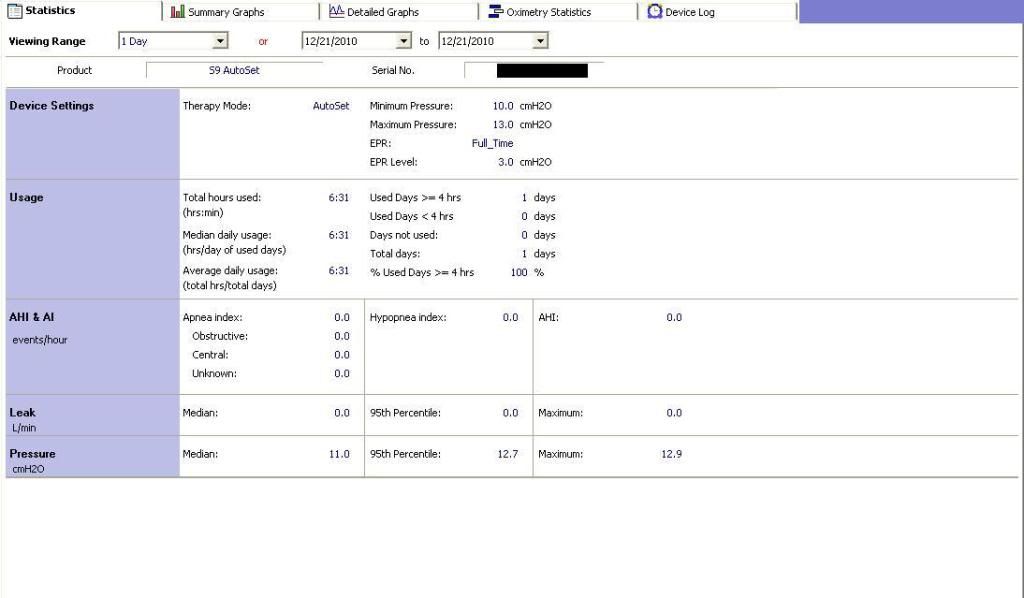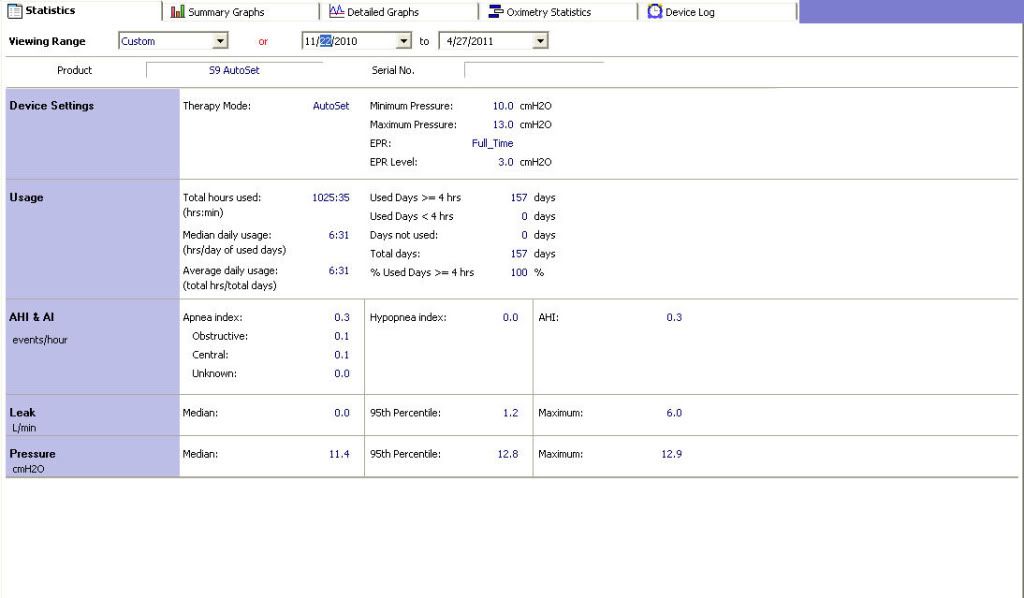Pugsy wrote:
Sometimes those numbers do seem to "add up" properly but I remember early on in therapy I had some really off the wall ones where it showed something like 60 events at one certain pressure but time spent in that pressure was relatively short as in maybe 15 minutes. Physical impossibility. For probably the same reasons you mention.
I can top this for impossible looking numbers: Last night's table had 633 in the box for VS at EPAP=5 for me. And of course, MaP for EPAP=5 was really short---something like 3 minutes or so.
Those kinds of numbers tease a mathematician right into the question "How can anybody possibly have 633 anythings occur in 3 minutes?"
But the answer is also obvious to the mathematician who knows everything in sleep apnea data gets converted to
indices: The number in the box is NOT the number of events that occurred at that pressure. It's the somewhat artificial
index for the events---i.e. it's the
average number of events expected to happen in one FULL HOUR of being at that pressure based on the actual data gathered in the limited amount of time at that pressure. So
- (x snores)/(three minutes) = 633 snores per hour and we need to convert the minutes to hours before we can continue with the arithmetic. Since 3 minutes = 1/20 hours, we get:
x/(1/20) = 633 where x
So x = 633/20 = 31.65 snores in 3 minutes
So that's about 10 snores per minute.
Since my respiration rate is about 12-16 breaths per minute, it's no wonder the pressure didn't stay at EPAP=5 for very long: I most likely STARTED snoring at the end of a very long (an uneventful) period with EPAP=4. So the machine raised the pressure up to EPAP=5 to see if that would help. But I continued snoring intensely enough for the machine to detect it on almost every breath and so it correctly continued to raise pressure on up to EPAP=6, where the snoring essentially stopped. So the VS numbers for both EPAP=4 and EPAP=6 were "normal" looking numbers---particularly when compared to their MaP numbers.
And so your "60 events" at "15 minutes at a certain pressure" doesn't mean 60 events. It means you had about 15 events in those 15 minutes at that pressure---about one per minute. Still excessive---particularly if the events are OAs or Hypops---but not at all impossible.
But I'll be honest: I'm be happy to agree that the numbers in the Daily Events per Hour table are largely unnecessary data.
But as a mathematician I do think OSA patients need to understand what those AHI numbers on our diagnostic PSGs really mean. And that requires understanding how REM AHI's are computed when there's mighty little REM sleep during the PSG. And the mathematics for understanding meaning the REM AHI is
exactly the same as the mathematics needed to understand the meaning of the numbers in the Daily Events per Hour table since the total REM time on a PSG is so often a (small) fraction of an hour.
Questions for the day: Suppose Mr. Sleepyhead has his PSG done. He sleeps for a total of 5 hours and 45 minutes. He gets 25 minutes of REM sleep. And his REM AHI = 72.0 and his NON-REM AHI = 37.5. What's his overall AHI for the night? And did Mr. Sleepyhead actually have more apneas and hypopneas in REM than NON-REM during the night? Why? As a hint, you might want to consider these questions instead: How many apneas and hypopneas did Mr. Sleepyhead actually have in REM? What about NREM? And note: None of these answers requires any more mathematics than basic arithmetic, the ability to convert time measured in minutes to hours, and an understanding of fractions to answer.
And I'll also be honest about this: My main interest in the "Daily Events per Hour" table is the break down of how much time I spent at each pressure. That's really all I look at unless something ridiculous jumps out at me like that 633 VSI today.
And final comment about all this for now: That table's name really needs a set of Parenthesis in it. It's written as
Daily Events per Hour and it's clear from many people's comments in trying to make sense of this data that they think the table is supposed to tell them something about
(Daily events) per hour---a break down of the data hour-by-hour in the night perhaps or they ignore the
per hour part of the title altogether and decide that it's a table showing
(Daily Events) per pressure setting and that the numbers represent the number of events that happened at each pressure setting. But the mathematical meaning of the numbers in the table indicates its title should be
Daily (Events per Hour) to make it clear that the numbers in the boxes are the overnight data converted into
Events per Hour Indices for each pressure level and not the actual number of events that took place at that pressure.




















